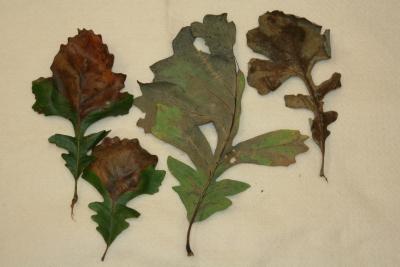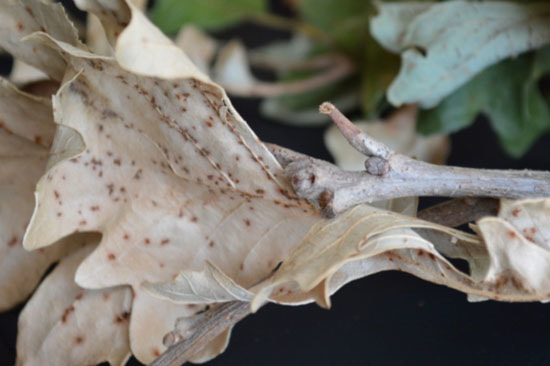web page by Emily Reif, 2018
Photo by: Iowa State University Forestry Extension
Background
Bur Oak Blight (BOB) is a severe leaf blight disease affecting bur oak trees (2). It was first identified in the Midwestern United States in the 1990s (1). Bur Oak Blight is the result of a fungal infection of the leaves, which causes petiole necrosis (death of the leaf stem) and then death of the entire leaf (1). The fungal infection is caused by the fungus Tubakia iowensis (1). This disease appears to increase in severity in individual trees from year to year (2). Bur Oak Blight spreads relatively slowly from tree to tree but seems to affect a variety of bur oak with small acorns (Quercus macrocarpa var. oliviformis) more severely (1,2).
Origin & Life Cycle
Bur Oak Blight is most commonly seen in Iowa and Minnesota, but has also been identified in western and southern Wisconsin, northern Kansas, eastern Nebraska, eastern South Dakota, and northern Illinois (1). The disease distribution aligns with the limited distribution of Q. macrocarpa var. oliviformis and has not been noted on the larger acorned, Q. macrocarpa var. macrocarpa (1). The disease lifecycle begins with black pustules (small raised spots) formed on the leaf stem, which provide the initial inoculum (figure 3) (1). The pustules then break open with wet spring conditions and conidia are dispersed by rain, which infects the shoots and leaves (1). Following a wet spring, susceptible trees are likely infected be remain asymptomatic for several months until petiole necrosissets in (1).
Signs & symptoms
- First signs and symptoms usually appear in early summer as long, purple-brown lesions on the veins of the underside of the leaf (1)
- Occasionally, small brown necrotic spots will also appear on the leaf (figure 1 & 2) (1)
- Fungal spores becomes evident after more substantial leaf death, usually starting in late June and persisting throughout the summer (1)
- Fungal fruiting structures appear on or near the necrotic leaf veins (1)
- Unseasonable leaf shedding or defoliation has been record during wet conditions in summer months (1)
- Death of the whole leaf typically occurs in late July through August (1)
- Black pustules form during late summer on dead leaf petioles (1)
Figure 1. Leaf necrosis caused by BOB
Photo by: T. Harrington, Iowa State University (3)
Photo by: T. Harrington, Iowa State University (3)
Figure 2. Leaf necrosis caused by BOB
Photo by: Fanny Iriarte, Extension Plant Pathology, Iowa State University
Photo by: Fanny Iriarte, Extension Plant Pathology, Iowa State University
Figure 3. Black pustules on past season leaves
Photo by: University of Illinois Extension
Home, Yard & Garden Newsletter Issue 14
Photo by: University of Illinois Extension
Home, Yard & Garden Newsletter Issue 14
Treatment & Control
- Injection of fungicide, which can be done by a trained arborist with a current pesticide applicator license, in late May and early June has been shown to reduce symptom development in the fall and following spring (3)
- However, fungicide may cause leaf browning and twig death (3)
- Fungicide may be effective for one or two years and will likely need to be reapplied in the spring following the reappearance of symptoms (3)
- Most bur oak trees are resistant to this disease and do not need fungicide treatment (3)
- Untreated trees, even with severe symptoms, will more than likely produce new green foliage the following year (3)
Work Cited
- Harrington, T. C., & McNew, D. L. (2016). Bur Oak Blight. In Diseases of Trees in the Great Plains. Rocky Mountain Research Station: USDA Forest Service.
- Pokorny, J. D., & Harrington, T. C. (2011). Bur oak blight. Newton Square, PA: USDA Forest Service, Northeastern Area, State and Private Forestry.
- Harrington , T. (2012, September 12). Update on Bur Oak Blight and a Potential Fungicide Treatment. Retrieved February 09, 2018, from https://hortnews.extension.iastate.edu/2012/9-12/buroakblight.html




